Summary
- To an untrained eye, stitching might seem like just a small detail on a garment. But anyone working in the industry knows how important the different types of sewing really are.
- For pattern makers, it’s not just about measurements. You also need to take it a step further and know which type of sewing is best for the garment you’re developing.
- Experience the future of the fashion industry with Audaces360. Start your free trial today!
Sewing is much more than joining pieces of fabric. Each stitch has a purpose, and the type of sewing you choose affects the result. For pattern makers, knowing the right technique makes all the difference.
That’s because a good pattern is only complete when it matches with the right sewing method. The seam affects how the garment fits, moves, and lasts.
If you choose the wrong type, even the best pattern might not deliver the expected result. That’s why we put together this article. Learn more about the top 8 types of sewing + hand-finished seam techniques.
Enjoy your reading!
Sumário
Why is it important to know the different types of sewing?
It’s important to know which type of sewing to use because your work becomes more professional. The seams last longer, the clothes fit better, and the result looks more polished.
This knowledge also helps you save time. You don’t waste hours fixing problems or redoing patterns. You can suggest the right method from the start and avoid mistakes.
Different fabrics need different types of sewing. For example, light fabrics may need delicate stitches, so they don’t get marks. Meanwhile, heavy materials need strong and durable seams. When you know the options, you make smarter choices.
If you work in a team, speaking the same “sewing language” helps. It makes communication easier between pattern makers, seamstresses, and designers.
In short, knowing the types of sewing gives you control. It helps you plan better, create better, and deliver results that meet high standards.
8 most used types of sewing in garment manufacturing
In garment manufacturing, understanding various sewing techniques is essential. Each type of sewing serves a specific purpose, affecting the durability, appearance, and comfort of the final product.
Below, we explore eight commonly used sewing methods in the industry:
1) Open seam
It’s one of the most basic and widely used sewing techniques. It involves placing two pieces of fabric together, right sides facing, and stitching along the edge of the fabric.
After sewing, the seam allowances are pressed open, lying flat on either side of the seam.
This method is straightforward and suitable for many types of garments. It’s common in areas where the seam won’t suffer significant stress, such as the sides of blouses or dresses.
The open seam provides a clean finish and is easy to iron, making it a favorite in many sewing projects.
2) Double stitch seam
The double stitch seam adds strength to garments by incorporating two rows of stitching. After sewing the initial seam, the seamstress adds a second line of stitching parallel to the first. It reinforces the seam and prevents it from unraveling.
It’s ideal for areas that experience more stress, like the crotch of pants or the underarm of shirts.
This type of sewing ensures durability and longevity, making it ideal for everyday wear and workwear garments.
3) Straight stitch
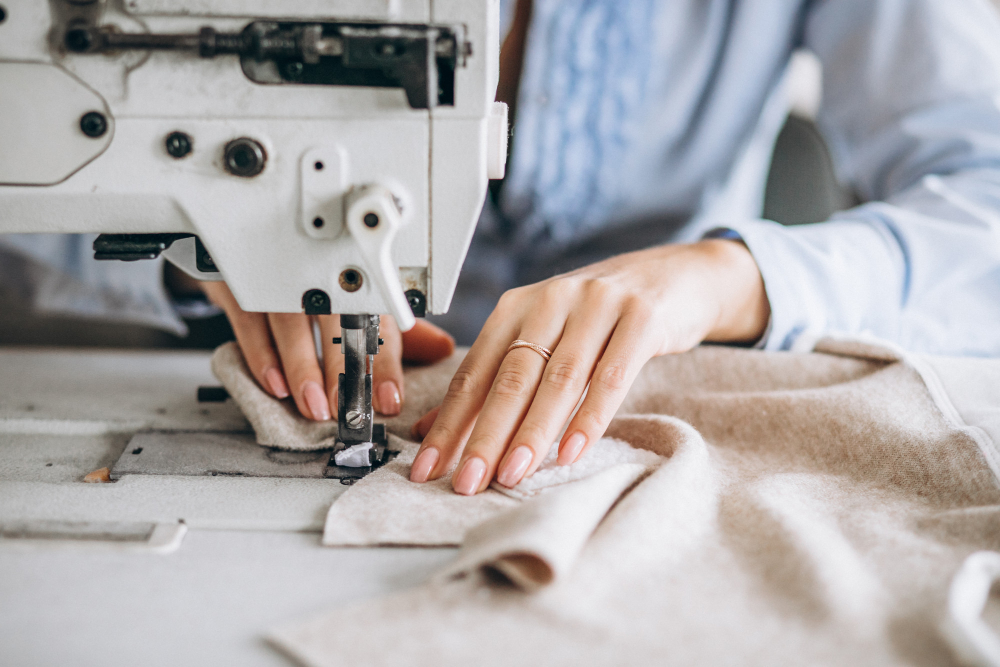
This is the most fundamental sewing technique, forming a straight line of stitches. It’s versatile and forms the basis of many other types of stitches.
It’s essential for seams, topstitching, and even decorative purposes.
Learn more: Learn how to use sewing darts in clothing manufacturing
4) Flat felled seam
The flat-felled seam is a sturdy and durable seam commonly found in jeans and men’s shirts. It involves folding and stitching the seam allowances in a way that encloses the raw edges. This is a way to provide a clean finish on both sides of the fabric.
It’s ideal for garments that require strong seams and a neat appearance. Moreover, it’s beneficial for items that will undergo frequent washing. This is because it prevents fraying and maintains the garment’s integrity over time.
5) Invisible stitch
Also known as blind hem stitch, it creates a seam that is barely visible on the outside of the fabric. It requires special foot for the machine, and it’s ideal for party dresses and formal wear.
To make this stitch, you need a blind hem foot attachment and a sewing machine that supports this function.
Seamstresses fold the fabric in a specific way, so the needle only catches a small part of the outer fabric. When done correctly, the stitches are nearly invisible from the outside.
6) Overlock stitch
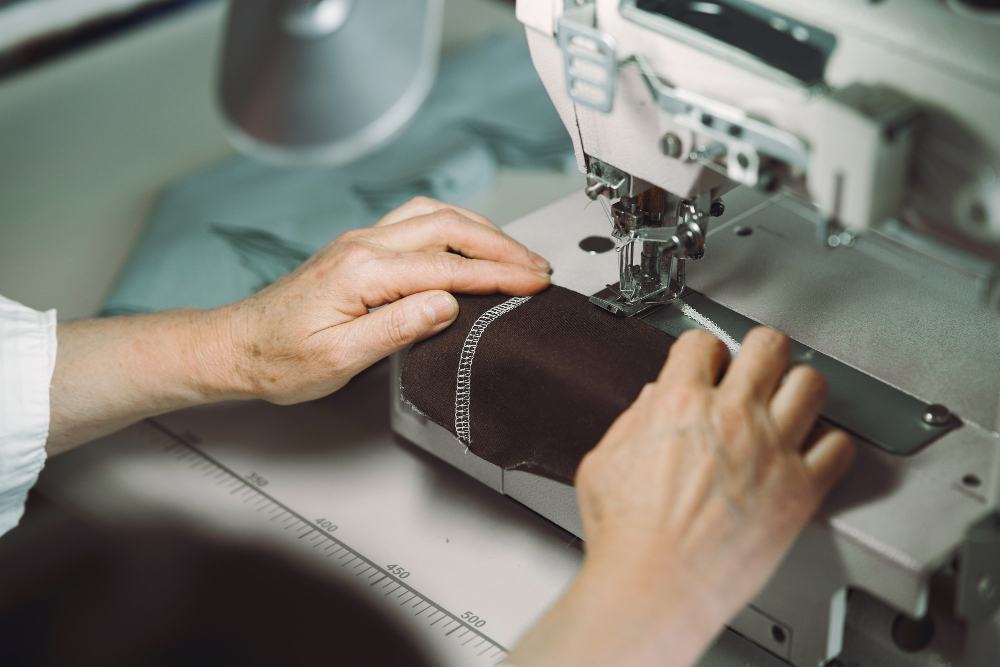
The overlock machine trims the fabric edge and encloses it with thread in one step, finishing the edges.
It’s perfect for knit garments, such as t-shirts and activewear, due to its flexibility and strength. This is also an efficient choice for mass production, as it speeds up the sewing process while ensuring quality.
7) French seam
This type of sewing encases the raw edges of the fabric within the seam, resulting in a neat finish. It’s particularly useful for lightweight or delicate fabrics where overlocking might be too bulky.
To create a French seam, professionals sew the fabric wrong sides together first. Then, they trim the seam allowance, turn the fabric right sides together and sew again.
The technique hides the raw edges and is common in high-quality garments like lingerie or fine blouses.
Learn more: Discover the benefits of digital sewing patterns and how they work
8) Zigzag stitch
The zigzag stitch is famous for its back-and-forth pattern, providing flexibility. It’s particularly useful for sewing stretchy fabrics or for finishing raw edges to prevent fraying.
This stitch can also be decorative, adding visual interest to garments. Adjusting the width and length of the zigzag allows for various applications, from functional seams to embellishments.
Want to gain even more knowledge to boost your career? Discover how technology is transforming fashion businesses. Explore the Audaces360 platform in our free ebook. Download it now!
Hand sewing techniques for finishing touches
Although not so common in large factories, hand sewing techniques still play an important role in smaller ateliers.
They are perfect for finishing details, luxury garments, or delicate fabrics. Each one has its purpose and adds value to the final garment.
Backstitch
Backstitch is strong and permanent. It’s often used in places where you need extra strength, like seams or repairs.
It mimics machine stitching, working well for tight areas or when a machine can’t reach certain parts of the garment.
Slip stitch
It’s ideal for closing linings or hems by hand, as it’s nearly invisible from the outside. This is a great choice when you want a clean look.
Pleat stitch
This hand sewing stitch is useful to secure pleats or folds in place. It helps keep the fabric structured and decorative.
It’s often done by hand in delicate or couture garments, where precision matters most.
Learn more: 4 types of pleats to take your designs to the next level
Basting stitch
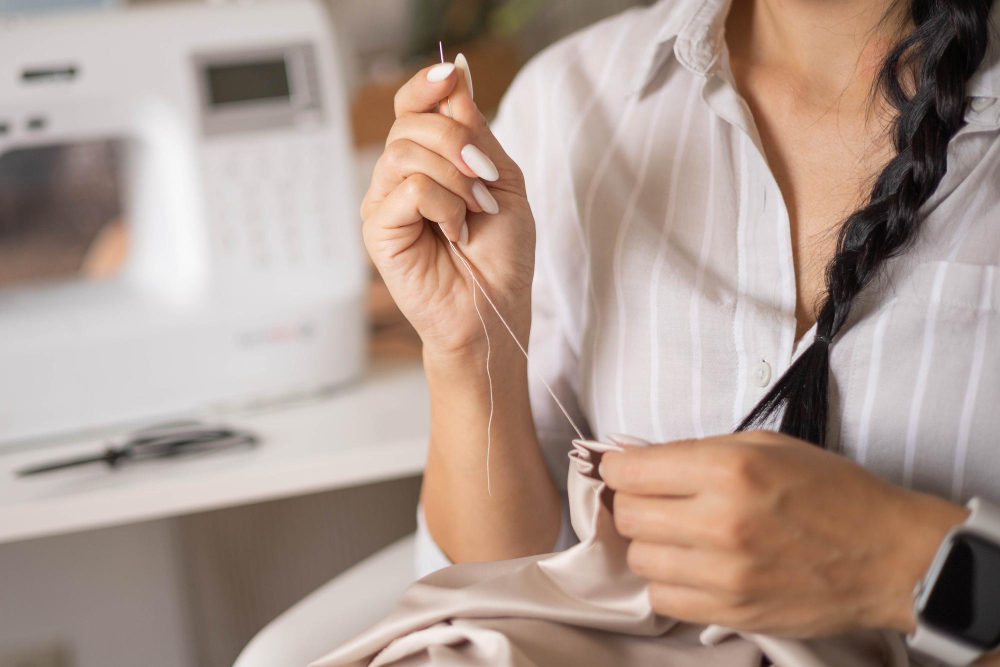
The basting stitch is temporary, just to hold fabric in place before machine sewing. It helps to check how the pieces fit together.
This stitch is large and easy to remove, perfect for testing fittings or layouts before final sewing.
Cross stitch
The cross stitch is decorative and strong. It forms an X-shape on the fabric and is perfect for thick materials.
It can create reinforcement or a visible detail, especially in handmade garments or embroidery-style finishes.
Buttonhole stitch
Seamstresses use this hand stitching around buttonholes to prevent fraying. It forms a thick and strong edge that protects the fabric.
While brands usually use machines for buttonholes today, the manual technique is still common for luxury pieces.
Learn more: 5 reasons why fashion houses should innovate with quality
Running stitch
The running stitch is simple and fast. It goes in and out of the fabric in a straight line. It’s great for gathering, temporary stitching, or even decorative details in some designs.
Overcast stitch
This stitch prevents raw fabric edges from fraying, wrapping around the edge in a loop.
While overlock machines often replace this method, it’s still useful for fine fabrics or delicate items.
Topstitch
Topstitching is an option for decoration or to reinforce seams. It’s often visible and adds style to the piece.
When done by hand, it requires precision. It’s common in couture and leather goods where attention to detail matters.
Learn more: 5 benefits of using technology as a partner in cut and sew
Main types of sewing machines and their stitches
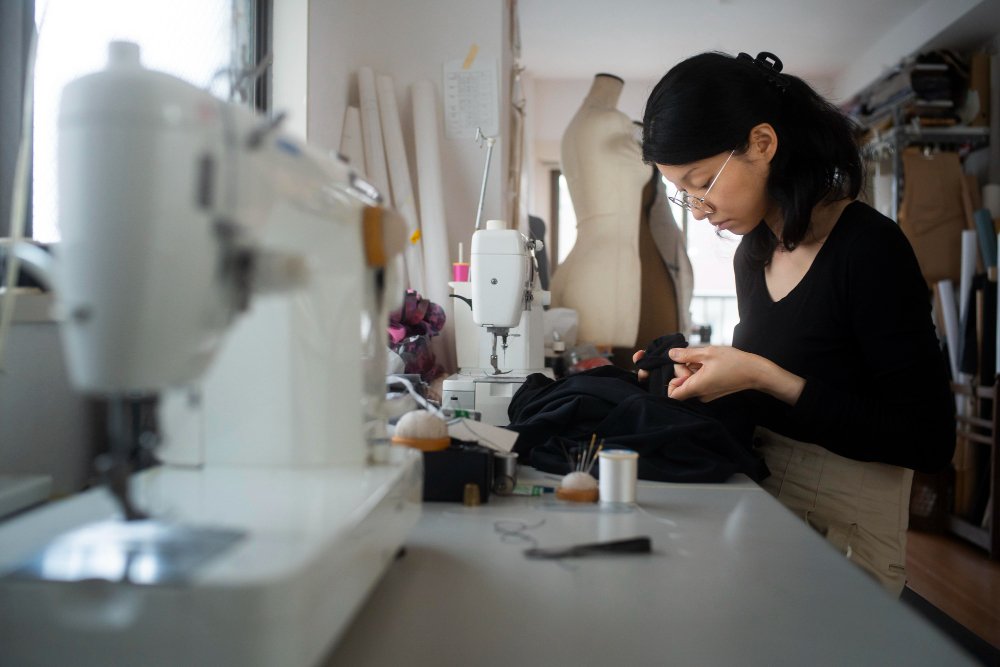
There are many types of sewing machines, and each one performs a different job. Knowing the main types of sewing machines and the stitches they can create helps you guide the seamstress’s work.
- Industrial embroidery machine: Used to create detailed embroidery quickly and on a large scale. It makes decorative stitches on clothes, logos, and designs.
- Interlock and coverstitch machine: Common in knitwear. It creates strong, stretchy seams and clean hems, especially on t-shirts and sportswear.
- Overlock machine: Also known as a serger, it finishes the edges of fabric to prevent fraying. It trims, sews, and overcasts all at once.
- Domestic sewing machine: A versatile machine used at home. It can do basic stitches like straight and zigzag and is great for small projects or repairs.
- Bartack machine: Used to reinforce areas that get a lot of stress, like pocket openings or belt loops. It makes short, dense stitches.
- Topstitch and flatlock machine: These machines create visible, neat seams and help close pieces of fabric with precision.
How does technology make the sewing process easier?
Technology makes the sewing process faster and more precise. With digital tools, it’s easier to design, cut, and sew garments. You don’t need to do everything by hand.
Modern sewing machines now come with smart features. They can cut fabric, add stitches, and even fix errors automatically.
Software also plays a big role. With it, you can design patterns, test fits in 3D, and plan fabric use before sewing starts. This helps avoid waste, saves materials, and view the final product without making a sample.
Learn more: 5 reasons why pattern makers should start using 3D pattern
Make your sewing process faster and more accurate with Audaces!
Learn how Audaces solutions assist with each stage of textile production, simplifying the sewing process.
Audaces Pattern
For pattern makers looking for excellence, Audaces Pattern is the perfect solution. It ensures the pattern design reaches a new level of efficiency and precision.
With its versatile approach, it’s possible to develop high-quality patterns, regardless of complexity.
Refine every detail to perfection, ensuring that your creative vision translates into patterns. This advanced solution will assist you with all your pattern making endeavors!
Audaces 3D
Audaces 3D is ideal for pattern makers to bring creations to life in a 3D mannequin.
You can test your digital pattern before committing to a physical sample. Save time and resources by identifying issues early in the process.
With a range of tools and possibilities, this software transforms the development processes.
It enables you to shape your ideas directly in a digital space, gaining agility and quality in deliveries.
Audaces Marker
Audaces Marker is the best solution to create a marker for cutting fabric with perfection. We used the best of technology to design it to improve the efficiency of the production process.
With this powerful ally, companies can lay out patterns in a way that reduces waste and makes the most of their raw materials.
It allows professionals to create markers more efficiently, saving both time and money.
Audaces Supera
Audaces Supera is a server capable of managing queues and ordering various markers for automatic calculation.
Reduce fabric waste even further, keeping your workstation free to prepare the next marker.
Our technology uses smart algorithms to arrange patterns on fabric in the most efficient way possible.
Discover Audaces360 and unlock a world of possibilities for fashion design and production. Explore our comprehensive suite of solutions today!
FAQ
It’s important to know which type of sewing to use because your work becomes more professional. The seams last longer, the clothes fit better, and the result looks more polished.
Common sewing types include the open seam, double stitch seam, straight stitch, and overlock stitch.
Interlock and coverstitch machine, overlock machine, bartack machine, topstitch and flatlock machine.





